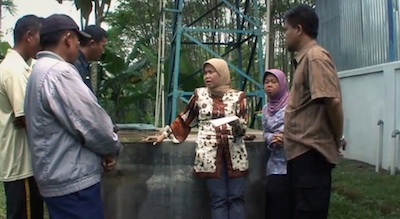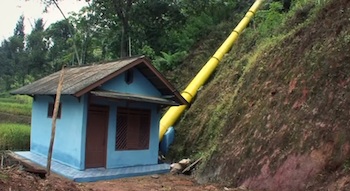Developing community-managed hydro schemes
 The Gunung Leuser biosphere reserve and national park covers a vast area of 1,094,692 ha of tropical rain forest in northern Sumatra. More than four million people live within or adjacent to the Gunung Leuser BR, with many different ethnic groups represented. Most of them are farmers and depend very much on the protection of this park for their subsistence. Paddy fields, mixed gardens, and small-scale and medium estates of rubber and oil-palm receive a consistent water supply from this park. But this water flow also represents a way for many communities to resolve their energy-poverty status.
The Gunung Leuser biosphere reserve and national park covers a vast area of 1,094,692 ha of tropical rain forest in northern Sumatra. More than four million people live within or adjacent to the Gunung Leuser BR, with many different ethnic groups represented. Most of them are farmers and depend very much on the protection of this park for their subsistence. Paddy fields, mixed gardens, and small-scale and medium estates of rubber and oil-palm receive a consistent water supply from this park. But this water flow also represents a way for many communities to resolve their energy-poverty status.
Despite a rapidly growing economy and thriving cities, over one third of the population of Indonesia lacks an electricity grid. Many people live in scattered communities on remote islands. Even on the densely-populated main island of Java, there are mountainous areas where the grid has not reached. This is the case of Putri Betung Subdistrict, within the biosphere reserve, where IBEKA has developed several projects.
IBEKA (Institut Bisnisdan Ekonomi Kerakyatan) works in partnership with communities to develop off-grid hydro schemes that stay in use. Through long-term involvement IBEKA makes sure that the community has the skills to manage and maintain the scheme, and community ownership which brings a continuing source of income.
Micro-hydro power at Gunung Leuser
The thirteen villages in Puteri Betung did not have electricity. Some people and village institutions used generators to fulfil their daily needs of electricity. The idea to develop micro-hidro projects to cover energy needs in this area started with a reset conducted by BRR (Agency for the Rehabilitation and Reconstruction of Aceh and Nias) with IBEKA, following the Indian Ocean tsunami.
One of the projects carried out, which is still showing tangible benefits is the construction of a micro-hydro power plant at Jamur Gele Village with a generating capacity of 43 KVA. Electricity is distributed to 350 homes at Jamur Gele Village and its surroundings. The community has created a Cooperative Economic Enterprise that would maintain the scheme, manage the subscriptions, operations and other village potentials.
The next step of this process was the construction of another plant at Aih Nuso with a capacity of 2 x 180 KVA. This scheme was handed-over in October 2008 and, along with Jamur Gele, will provide electricity for 7 villages in Northern Gumpang.
Another programme that is worth mentioning has been developed at Kreung Kala Village, in the Aceh province. The village was damaged by Tsunami and earthquake. Electricity was one of the critical needs to recover the village. Through international cooperation this problem was overcome by developing electrical power supply based on micro hydro. A 40 KVA plant was installed in the village by IBEKA and Nurani Dunia Foundations, financed by PT Coca Cola, achieving the electrification of 200 households. Besides giving the benefit in the form of electrification and local welfare improvement, the program also aimed to improve the local awareness in nurturing their forest.
Community ownership and management
IBEKA’s core principles are that a hydro scheme must be developed with the community, in order to meet its specific needs, that the community should have long term responsibility for management, and that the community should have long-term benefits. For off-grid schemes, a community organisation manages and legally owns the scheme. This could be an existing organisation or a specially established community co-operative. The organisation is responsible for collecting fees, paying staff, and building up the maintenance and community funds. Each year the community reviews performance and prioritises the use of funds.
For grid-connected schemes, the community organisation is usually constituted as a social enterprise. This is responsible for making payments for bank loans or private investors, as well as the operation, maintenance and community fund.
The social benefits of bringing electricity to off-grid communities are substantial. Smoky kerosene lamps are no longer needed, and bright electric lights make study and housework easier, and homes more pleasant. Having lights outside houses makes families feel less isolated at night. Radio, television and mobile phones bring information, entertainment and connection to the wider world.
Lessons learned and replicability
There is a continuing need for off-grid hydro in Indonesia, since over one third of the population is not connected to the grid. IBEKA continues to source grant funding and work with communities to provide off-grid systems.
Given the shortage of capacity on the Indonesian grid, there is also significant potential for grid-connected micro and mini hydro. IBEKA has seven such schemes totalling nearly 10 MW (four times its current installed capacity) under development, and is sourcing loan and investment finance for them. IBEKA itself is investing in grid connected schemes, to generate a reliable income stream for its work.
IBEKA has demonstrated that community management of hydro systems, and community benefit from them, can be achieved with a range of different financing mechanisms. The successful solutions acquire special importance if we take into account that, according to a survey by GTZ found over 1,000 micro-hydro plants that had been abandoned through lack of maintenance. This model is widely relevant in other countries.
















